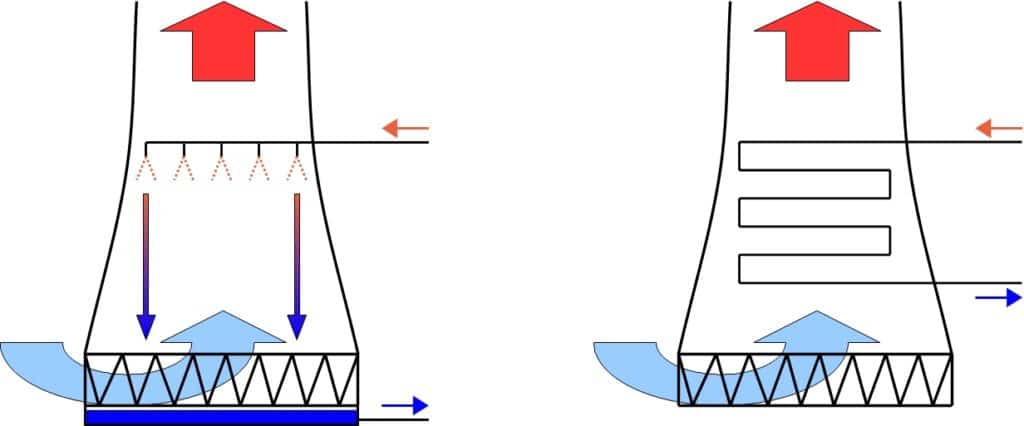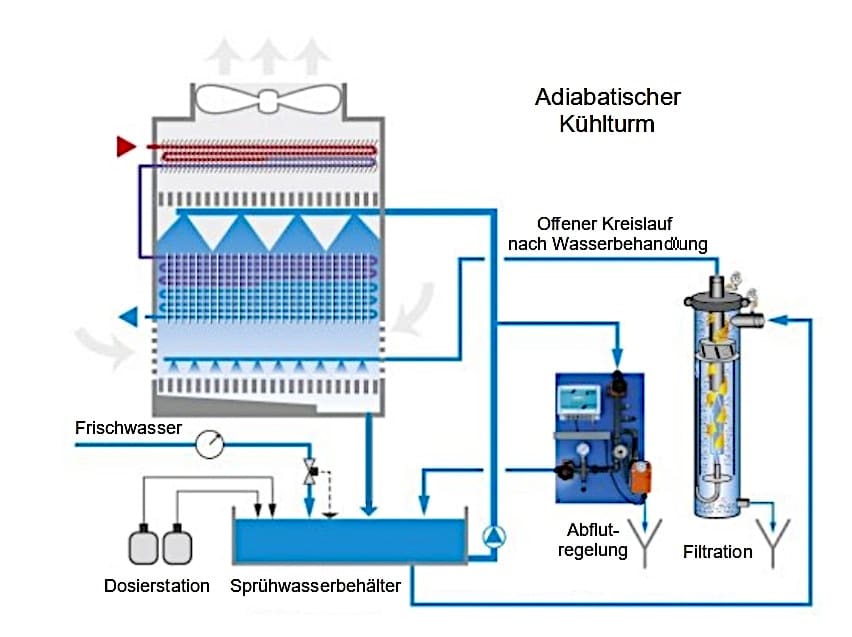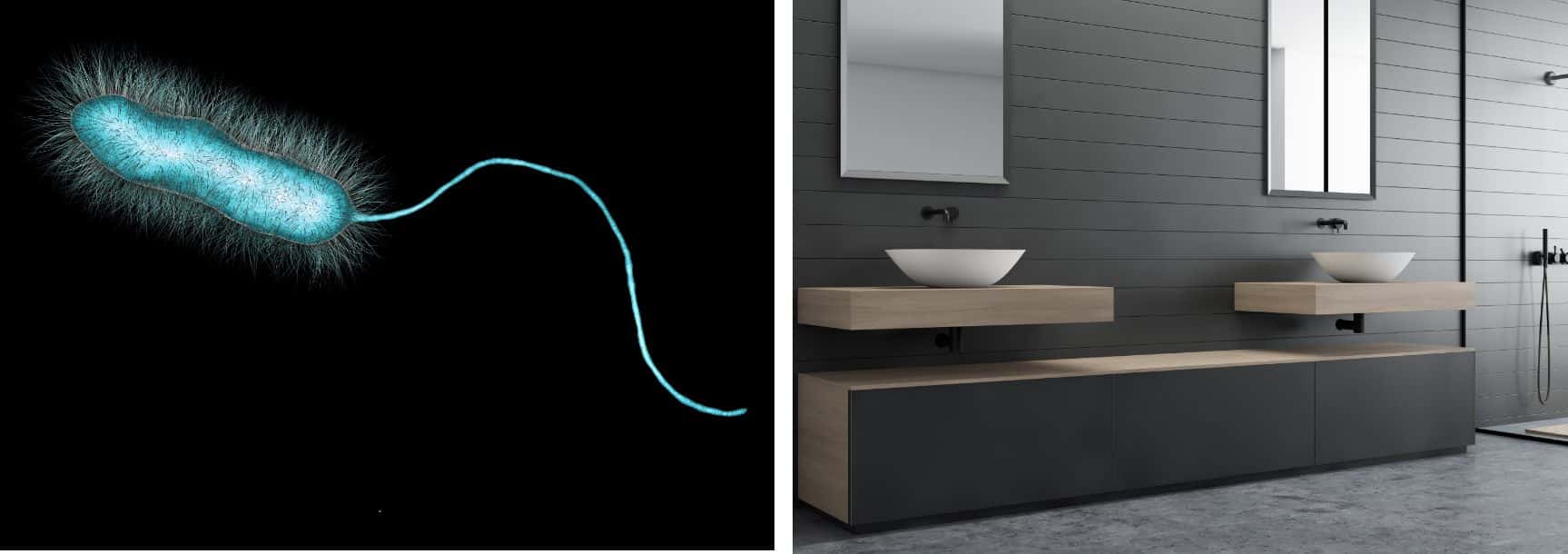comprex® - The mechanical cleaning with air and water
comprex® as an alternative to the chemical cleaning of cooling circuits
What types of cooling circuits are there?
In industry today, there are still many open cooling circuits. Wet cooling towers are used for heat transfer (Fig. 1). The water to be cooled is in direct contact with the air flowing against it. In the process, part of the water evaporates and consequently has to be replaced in the cycle. If demineralized water is not used for this purpose, the circulated water is enriched with water constituents, mostly salts (thickening). It is then necessary to exchange, desalinate the water above a certain salt content. Unlike wet cooling towers, dry cooling towers allow closed cooling circuits without water evaporation and its associated problems, but with reduced efficiency.

Open cooling towers behave like air purifiers. They enrich the cooling water with dust, pollen and other substances. These are nutrients for microorganisms. The entrained particles, together with biofilm, lead to cross-sectional constriction in piping and other components of the cooling system. The effectiveness of the plant decreases. Measures are required. This basically involves two measures: water treatment and cleaning of the plant.
Modern cooling towers are often combinations of both systems according to Fig. 1. One cooling circuit is closed, the other is open. Figure 2 shows such a cooling tower with both systems. The water of the closed cooling circuit advantageously runs over heat exchangers in the open cooling tower. The water in the open evaporative cooling circuit, on the other hand, requires mechanical and chemical treatment.
Hersteller von Verdunstungskühlanlagen unterscheiden 3 Kühlturmbauformen mit entsprechendem näherungsweisem Anteil an Wasser- und Luftkühlung:
Kühlturmart
Wasserkühlung
Luftkühlung durch Ventilatoren
Nasskühlturm
Hybridkühlturm
Adiabatischer Kühlturm
90 %
50 %
10 %
10 %
50 %
90 %

The water treatment of cooling circuits and its limitations
The water treatment in the closed cooling circuit depends on the general conditions such as materials, operating temperature and water quality. For example, corrosion inhibitors may be required for components made of low-alloy steels in combination with plastic lines and hoses as a result of oxygen permeation.
In the evaporation circuit shown in Fig. 2, desalinated water is often not used as fresh water. Water treatment consists of filtration, discharge control, dosing of inhibitors and biocides. It is used to condition the water in this circuit in order to remove the production heat from the system as uniformly as possible at all times. In addition, however, it must also be ensured that emissions from the wet cooling tower are not harmful. Microbial contamination can be critical here due to ideal temperatures for Legionella growth.
Despite water treatment, it is repeatedly seen that deposits form in the cooling circuits. In contrast to cleaning with chemicals, intensive mechanical cleaning with comprex® offers many advantages:
- Economical and proven cleaning process
- Simple connection options for existing pipelines and systems
- Suitable for all geometric conditions in pipelines and plants
- Compressed air pulses generate air pigs
- Hygienic work in drinking water supply systems
- Gentle on materials
- Low downtime
- Cleaning partially possible during operation
- comprex® available as a service or stationary process-integrated technology
When is comprex® cleaning recommended?
The temperature difference at indicators before and after the heat exchangers and cooling towers (delta-T temperature indicators) serves as an indicator for blowdown and finally for Comprex cleaning. Certain limits for the biocides used are intended to ensure that no dangerous microbial contamination and ultimately emissions occur. Indicators, corresponding sensors and measuring devices depend on the chemicals used for inhibitors and biocides. Hydraulic characteristic curves are suitable for the evaluation of pipelines and plant components. The data required for pressure and flow come from corresponding sensors.
What rules apply to the operator of cooling circuits?
Finally, let’s take a look at the regulatory background. The 2015 World Climate Conference in Paris set the 1.5°C target by 2050. Many small measures can contribute to achieving this. This includes the optimal operation of cooling circuits. In the same year 2015, VDI 2047-2 was published with the title “Ensuring hygienic operation of evaporative cooling systems”. Since 2016, VDMA 24659 has applied with regard to the economic efficiency andCO2 footprint of evaporative cooling circuits. In addition, since 2017, the 42nd BImSchV has wanted to know where such systems are in use in production plants everywhere in Germany: https://kavka.bund.de/
What can be expected for the future?
Since there are open cooling towers in many industrial cooling circuits and the requirements of the existing regulations must be met, appropriate maintenance measures are essential. Seasonal and weather-related influences affect the system throughout the year.
Despite optimal water treatment, there comes a time when mechanical system cleaning is required. With comprex®, this work can be carried out in a targeted, efficient and reliable manner. System size independent, industry independent. Everywhere where 42.BImSchV covered cooling circuits are in operation.
Application examples of comprex® in cooling circuits
Mold cleaning at KraussMaffei
Cooling systems steel manufacturer
More practical examples – cooling systems










